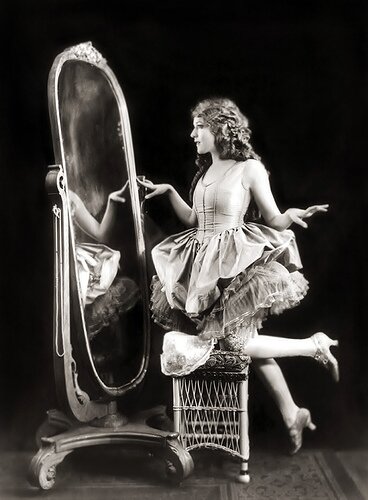The history of Canadian actors is unlike the history of Canadians in any other medium. Canadian novelists are celebrated at home and barely noticed abroad. Canadian musicians are oddities and curiosities with hardcore fanbases. Canadian directors are singular visionaries who engage (or refuse to engage) with the meaning of life itself.
But Canadians have been such an integral part of Hollywood that you have to remind people that a famous actor is, or was Canadian. And so, as I introduce the archetypal Canadian actress – Gladys Smith, aka Mary Pickford – I really have to squint to pick out what makes her Canadian.
She was not a pioneer like Lillian Gish. She was not mysterious like Garbo. She did not radiate sex like Clara Bow, and she was not smeared with scandal and tragedy like Marion Davies. As an actress, her persona was pretty, sweet, innocent and unassuming, with long curls that she refused to cut until her infamous turn in 1929’s Coquette. She literally was Pollyanna, playing her in 1920.
She was not a saint – thrice-married, she struggled with alcohol, was a neglectful mother, and had a tendency to fire cameramen for interrupting her during takes. But she perfectly played the role so many Canadians have stepped into since: the blank screen, onto which people project their hopes and fantasies.
During World War I she was the public face of Liberty Bonds, selling them by the hundreds of thousands. She formed an early power couple with Douglas Fairbanks, hosting the cream of the 1920s art world at their Pickfair redoubt in Beverly Hills. She co-founded United Artists studios and continued to produce films well into the 1950s. Never the first to do anything, she won the second-ever Academy Award for Best Actress.
This tension between the “America’s Sweetheart” public persona and the shrewd and capable businesswoman is, I feel, what makes her uniquely Canadian. Because she did not pigeonhole herself, she demonstrated amazing versatility. She gave the people what they wanted during the Great War, and when her lack of voice talent was exposed, she quickly retired from the spotlight, devoting herself to building Hollywood into what it is today. She avoided the depths of scandal while embracing the starlet lifestyle. When it suited her, she could be an independent flapper or a paragon of innocence, a patriotic Canadian who would kiss the American flag and give speeches at Wall Street, and above all, a skilled diplomat who could work around colossal egos, like that of Charlie Chaplin’s, for years. For the most part she was careful, measured, and built an enduring legacy. Mostly, she seems to have been perfectly suited for the amoral world of Hollywood.
Next week, we will cover the intersection of Broadway and Hollywood when we present the living treasure, Christopher Plummer.
*****
See the previous installments in the series:
Part 1 on Heroes: ‘Scott Pilgrim Vs The World’ Vs Terrance Denby and ‘Sidequest’
Part 2 on “Humour”: The Libertarian Fantasy of ‘Letterkenny’
Part 3 on Graphic Novel Nihilism: The Harsh Truths of ‘Essex County’
Part 4 on Spawn and Wolverine: Banished From The Promised Land: A Tale of Two Canadian Anti-Heroes
Part 5 on Science Fiction Dystopias: Inside Quebec’s – and Canada’s – Replicant Culture
Part 6 on Animation: The Garrison Mentality: More Than Meets The Eye
Part 7 on Pop Music: How To Build A Successful Canadian Musical Act
Part 8 on Anne of Green Gables and The Traumatized Artist: Lucy Maud Montgomery’s Treacherous Alpine Path
Part 9 on Avoiding the Serious: Mordecai Richler, Montreal, And Gritty Realism
Part 10 on Southern Ontario Gothic: The Marriage of the Mundane and the Fantastic
Part 11 on Margaret Atwood’s Reign of Terror: Literary Tyranny and The Handmaid’s Tale
Part 12 on the First Nations Fraud: Whitewashing Genocide: Truth, Lies, and Joseph Boyden
Part 13 on the inventive Esi Edugyan: A Novel I Cannot Recommend Enough
Part 14 on Generation X Origins: Douglas Coupland And The Hopeful (?) Future Of Canadian (?) Culture
Part 15 on Jordan Peterson Rising: Canadian Culture Creators And The Intellectual Dark Web
Part 16 on The Awkward Quiet: David Cronenberg’s Silent Hell
Part 17 on The Saddest Music In The World: Guy Maddin’s Surrealist Madness
Part 18 on Ararat: Atom Egoyan’s Stammering Grief
Part 19 on Paul Haggis’ Superficial Gloss: Promising More Than He Delivers
Part 20 on the Reitman Family’s Blissful Ignorance: Space to Laugh an Easy Laugh
Photo by twm1340 



Comments
Leave a Reply